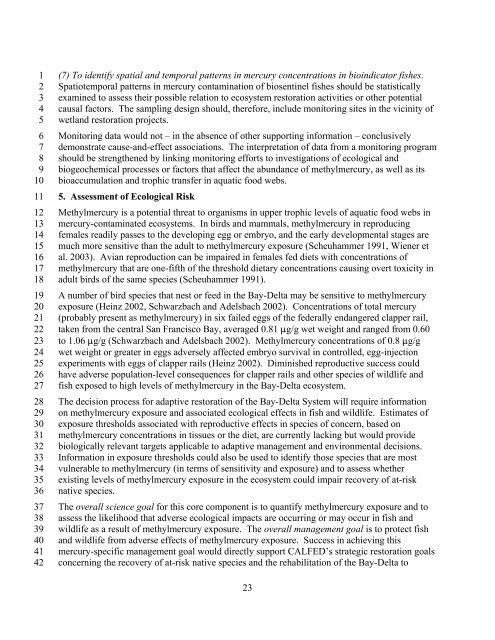Mercury Strategy for the Bay-Delta Ecosystem - CALFED Bay-Delta ...
Mercury Strategy for the Bay-Delta Ecosystem - CALFED Bay-Delta ...
Mercury Strategy for the Bay-Delta Ecosystem - CALFED Bay-Delta ...
Create successful ePaper yourself
Turn your PDF publications into a flip-book with our unique Google optimized e-Paper software.
1<br />
2<br />
3<br />
4<br />
5<br />
6<br />
7<br />
8<br />
9<br />
10<br />
11<br />
12<br />
13<br />
14<br />
15<br />
16<br />
17<br />
18<br />
19<br />
20<br />
21<br />
22<br />
23<br />
24<br />
25<br />
26<br />
27<br />
28<br />
29<br />
30<br />
31<br />
32<br />
33<br />
34<br />
35<br />
36<br />
37<br />
38<br />
39<br />
40<br />
41<br />
42<br />
(7) To identify spatial and temporal patterns in mercury concentrations in bioindicator fishes.<br />
Spatiotemporal patterns in mercury contamination of biosentinel fishes should be statistically<br />
examined to assess <strong>the</strong>ir possible relation to ecosystem restoration activities or o<strong>the</strong>r potential<br />
causal factors. The sampling design should, <strong>the</strong>re<strong>for</strong>e, include monitoring sites in <strong>the</strong> vicinity of<br />
wetland restoration projects.<br />
Monitoring data would not – in <strong>the</strong> absence of o<strong>the</strong>r supporting in<strong>for</strong>mation – conclusively<br />
demonstrate cause-and-effect associations. The interpretation of data from a monitoring program<br />
should be streng<strong>the</strong>ned by linking monitoring ef<strong>for</strong>ts to investigations of ecological and<br />
biogeochemical processes or factors that affect <strong>the</strong> abundance of methylmercury, as well as its<br />
bioaccumulation and trophic transfer in aquatic food webs.<br />
5. Assessment of Ecological Risk<br />
Methylmercury is a potential threat to organisms in upper trophic levels of aquatic food webs in<br />
mercury-contaminated ecosystems. In birds and mammals, methylmercury in reproducing<br />
females readily passes to <strong>the</strong> developing egg or embryo, and <strong>the</strong> early developmental stages are<br />
much more sensitive than <strong>the</strong> adult to methylmercury exposure (Scheuhammer 1991, Wiener et<br />
al. 2003). Avian reproduction can be impaired in females fed diets with concentrations of<br />
methylmercury that are one-fifth of <strong>the</strong> threshold dietary concentrations causing overt toxicity in<br />
adult birds of <strong>the</strong> same species (Scheuhammer 1991).<br />
A number of bird species that nest or feed in <strong>the</strong> <strong>Bay</strong>-<strong>Delta</strong> may be sensitive to methylmercury<br />
exposure (Heinz 2002, Schwarzbach and Adelsbach 2002). Concentrations of total mercury<br />
(probably present as methylmercury) in six failed eggs of <strong>the</strong> federally endangered clapper rail,<br />
taken from <strong>the</strong> central San Francisco <strong>Bay</strong>, averaged 0.81 :g/g wet weight and ranged from 0.60<br />
to 1.06 :g/g (Schwarzbach and Adelsbach 2002). Methylmercury concentrations of 0.8 :g/g<br />
wet weight or greater in eggs adversely affected embryo survival in controlled, egg-injection<br />
experiments with eggs of clapper rails (Heinz 2002). Diminished reproductive success could<br />
have adverse population-level consequences <strong>for</strong> clapper rails and o<strong>the</strong>r species of wildlife and<br />
fish exposed to high levels of methylmercury in <strong>the</strong> <strong>Bay</strong>-<strong>Delta</strong> ecosystem.<br />
The decision process <strong>for</strong> adaptive restoration of <strong>the</strong> <strong>Bay</strong>-<strong>Delta</strong> System will require in<strong>for</strong>mation<br />
on methylmercury exposure and associated ecological effects in fish and wildlife. Estimates of<br />
exposure thresholds associated with reproductive effects in species of concern, based on<br />
methylmercury concentrations in tissues or <strong>the</strong> diet, are currently lacking but would provide<br />
biologically relevant targets applicable to adaptive management and environmental decisions.<br />
In<strong>for</strong>mation in exposure thresholds could also be used to identify those species that are most<br />
vulnerable to methylmercury (in terms of sensitivity and exposure) and to assess whe<strong>the</strong>r<br />
existing levels of methylmercury exposure in <strong>the</strong> ecosystem could impair recovery of at-risk<br />
native species.<br />
The overall science goal <strong>for</strong> this core component is to quantify methylmercury exposure and to<br />
assess <strong>the</strong> likelihood that adverse ecological impacts are occurring or may occur in fish and<br />
wildlife as a result of methylmercury exposure. The overall management goal is to protect fish<br />
and wildlife from adverse effects of methylmercury exposure. Success in achieving this<br />
mercury-specific management goal would directly support <strong>CALFED</strong>’s strategic restoration goals<br />
concerning <strong>the</strong> recovery of at-risk native species and <strong>the</strong> rehabilitation of <strong>the</strong> <strong>Bay</strong>-<strong>Delta</strong> to<br />
23

















